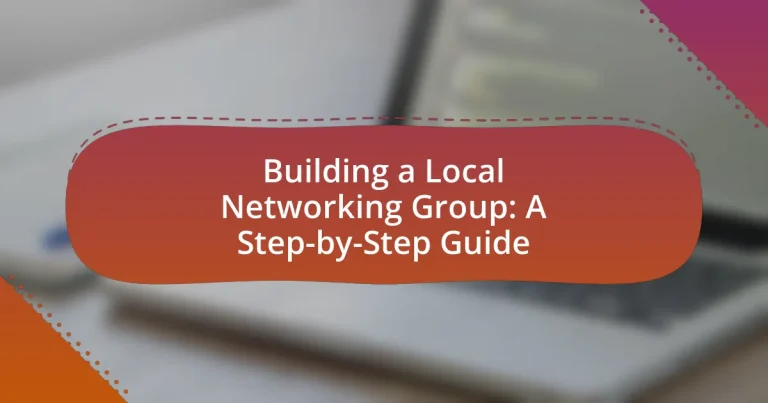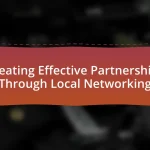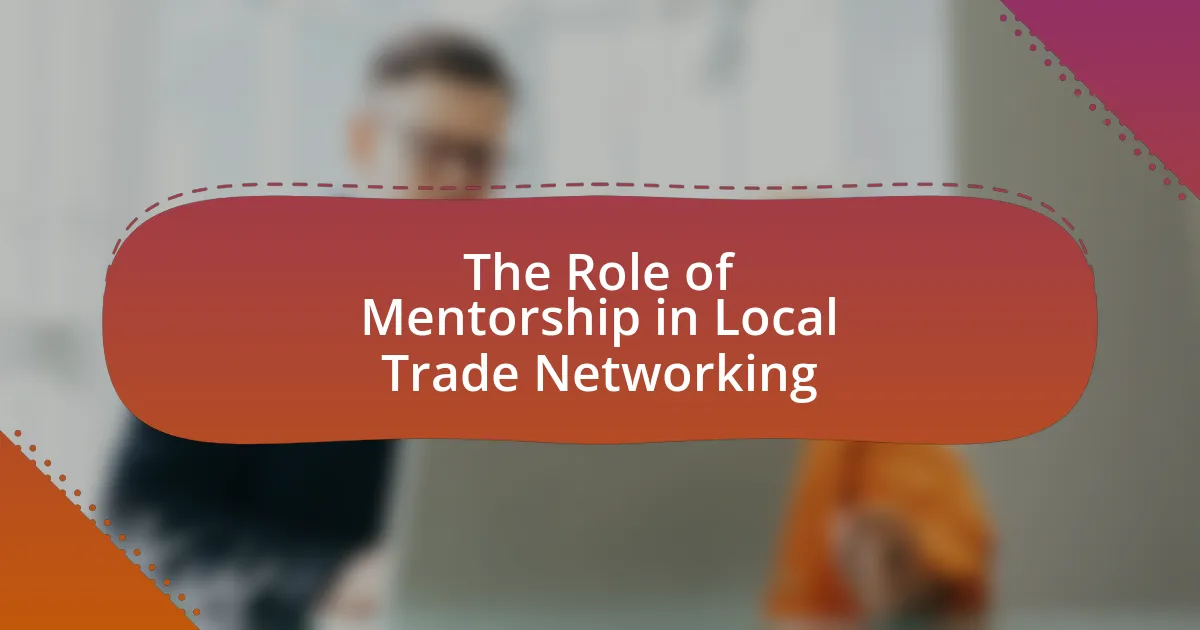A Local Networking Group is a community of individuals or businesses that collaborate to share resources and create professional connections within a specific geographic area. This article provides a comprehensive guide on building a Local Networking Group, detailing its key components, functions, and benefits, including enhanced professional relationships and collaboration opportunities. It outlines practical steps for establishing and promoting the group, managing member engagement, and addressing common challenges such as low attendance and conflict resolution. Additionally, best practices for sustaining a successful networking group are discussed, emphasizing the importance of clear objectives, effective communication, and regular feedback.
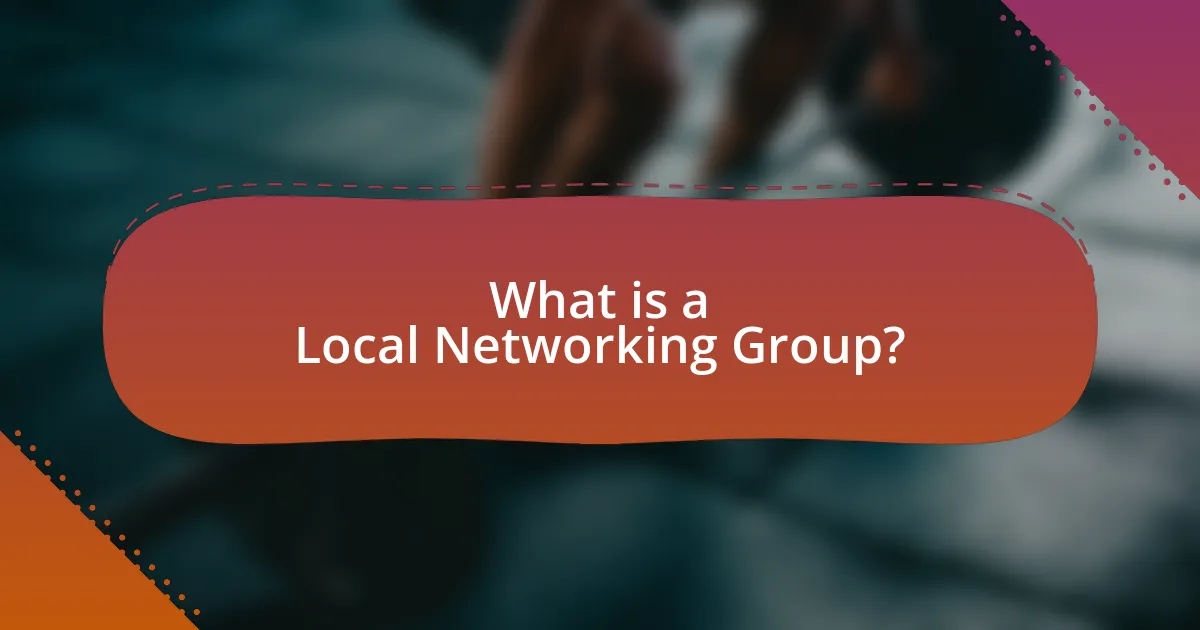
What is a Local Networking Group?
A Local Networking Group is a community of individuals or businesses that come together to share resources, support each other, and create professional connections within a specific geographic area. These groups often facilitate networking events, workshops, and meetings to foster collaboration and business growth. According to a study by the Kauffman Foundation, local networking can significantly enhance business opportunities, as 70% of entrepreneurs report that networking is crucial for their success.
How do Local Networking Groups function?
Local networking groups function by bringing together individuals from similar industries or interests to foster professional relationships and collaboration. These groups typically organize regular meetings, events, or workshops where members can share resources, exchange referrals, and provide support to one another. For example, according to a study by the Kauffman Foundation, networking is a critical factor for small business success, as it enhances visibility and access to opportunities. Members often benefit from shared knowledge and experiences, which can lead to increased business growth and personal development.
What are the key components of a Local Networking Group?
The key components of a Local Networking Group include a defined purpose, a diverse membership base, regular meetings, effective communication channels, and structured activities. A defined purpose ensures that all members understand the group’s goals, which can range from professional development to business referrals. A diverse membership base brings various perspectives and expertise, enhancing the group’s value. Regular meetings foster relationship-building and networking opportunities, while effective communication channels, such as newsletters or social media, keep members informed and engaged. Structured activities, like workshops or guest speaker events, provide learning opportunities and facilitate networking among members. These components collectively contribute to the success and sustainability of a Local Networking Group.
How do these components contribute to the group’s success?
The components of a local networking group, such as effective communication, shared goals, and diverse skill sets, significantly contribute to the group’s success by fostering collaboration and enhancing resource sharing. Effective communication ensures that all members are informed and engaged, which leads to stronger relationships and trust among participants. Shared goals align the efforts of the group, motivating members to work together towards common objectives, thereby increasing overall productivity. Diverse skill sets bring various perspectives and expertise, enabling innovative problem-solving and a more comprehensive approach to challenges. These elements collectively create a supportive environment that encourages growth and success within the group.
What are the primary benefits of joining a Local Networking Group?
Joining a Local Networking Group primarily benefits individuals by providing opportunities for professional connections, collaboration, and business growth. These groups facilitate face-to-face interactions, which can lead to referrals and partnerships, enhancing one’s professional network. According to a study by the Harvard Business Review, networking can significantly increase job opportunities and career advancement, with 70% of jobs being found through networking. Additionally, members often share resources, knowledge, and support, fostering a collaborative environment that can lead to innovative ideas and solutions.
How can Local Networking Groups enhance professional relationships?
Local Networking Groups enhance professional relationships by providing a platform for individuals to connect, share resources, and collaborate on opportunities. These groups facilitate face-to-face interactions, which are crucial for building trust and rapport among members. Research indicates that 85% of jobs are filled through networking, highlighting the importance of personal connections in professional advancement. Additionally, members often share industry insights and referrals, further strengthening their professional ties. By participating in Local Networking Groups, individuals can expand their networks, gain valuable knowledge, and foster mutually beneficial relationships that can lead to career growth and new business opportunities.
What opportunities for collaboration do Local Networking Groups provide?
Local Networking Groups provide opportunities for collaboration by facilitating connections among members, enabling resource sharing, and fostering partnerships. These groups often host events, workshops, and meetings that encourage members to exchange ideas, collaborate on projects, and support each other’s businesses. Research indicates that 70% of professionals attribute their career success to networking, highlighting the importance of these collaborative opportunities in enhancing professional growth and development.
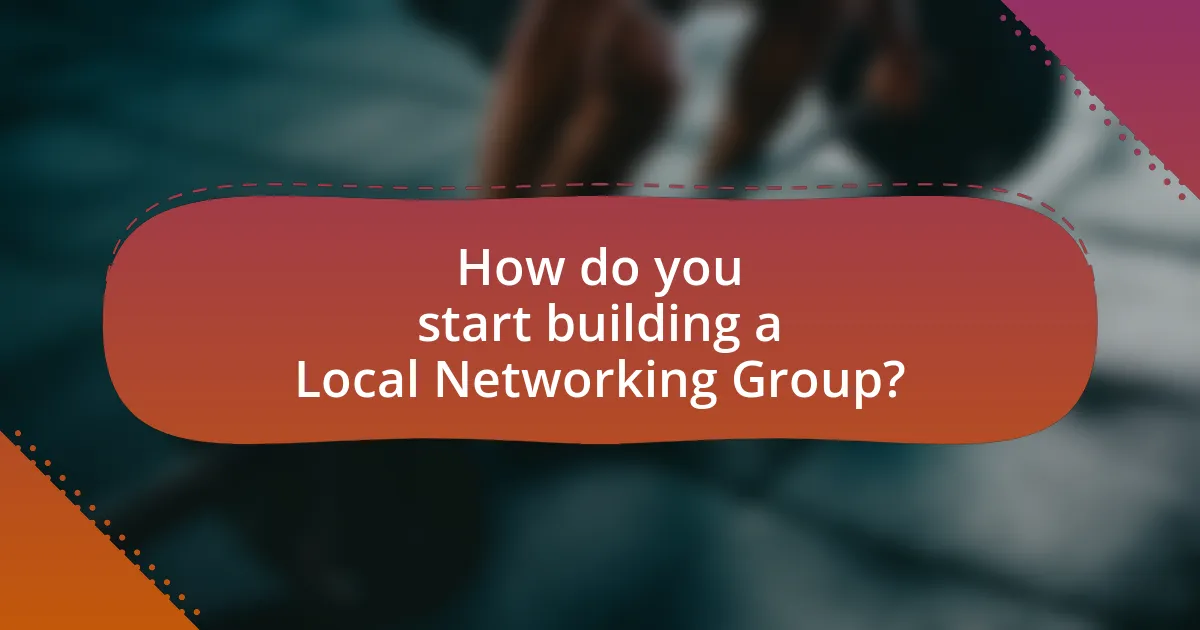
How do you start building a Local Networking Group?
To start building a Local Networking Group, first identify a specific purpose or theme that resonates with your target audience, such as professional development or community service. Next, gather a small group of interested individuals to brainstorm ideas and establish a clear mission statement. Following this, choose a suitable venue for meetings, which could be a local café, community center, or online platform, ensuring it is accessible to all members. Promote the group through social media, local events, and word of mouth to attract more participants. Finally, schedule regular meetings and create an agenda to facilitate networking opportunities and discussions, fostering a sense of community and collaboration among members.
What initial steps should you take to establish a Local Networking Group?
To establish a Local Networking Group, first identify a clear purpose and target audience for the group. This foundational step ensures that the group attracts individuals with shared interests and goals, which is crucial for effective networking. Next, select a suitable location for meetings, such as community centers or local cafes, to facilitate accessibility and comfort for members. Additionally, create a marketing strategy to promote the group through social media, local events, and word-of-mouth, which can significantly increase visibility and membership. Finally, schedule regular meetings to foster engagement and build relationships among members, as consistent interaction is key to a successful networking group.
How do you identify your target audience for the group?
To identify your target audience for the group, conduct thorough market research to understand the demographics, interests, and needs of potential members. This involves analyzing local community data, surveying potential participants, and reviewing existing networking groups to identify gaps and opportunities. For instance, a study by the Pew Research Center indicates that understanding demographic trends can significantly enhance group engagement, as tailored approaches resonate more with specific audiences.
What resources are necessary for launching the group?
To launch a group, essential resources include a clear purpose, a dedicated team, a budget, a venue, and promotional materials. A clear purpose defines the group’s mission and goals, guiding its activities and attracting members. A dedicated team is necessary for organizing events and managing operations, ensuring the group runs smoothly. A budget is crucial for covering costs such as venue rental, marketing, and materials; for instance, a study by the Nonprofit Finance Fund indicates that 70% of nonprofits struggle with financial sustainability, highlighting the importance of budgeting. A venue provides a physical space for meetings and events, which can be sourced through community centers or local businesses. Lastly, promotional materials, including flyers and social media content, are vital for attracting members and raising awareness about the group.
How can you effectively promote your Local Networking Group?
To effectively promote your Local Networking Group, utilize social media platforms to reach a wider audience and engage potential members. Research indicates that 73% of marketers believe that their efforts through social media have been “somewhat effective” or “very effective” for their business (Buffer, 2021). Create a dedicated page for your group on platforms like Facebook and LinkedIn, where you can share events, success stories, and networking tips. Additionally, collaborate with local businesses and organizations to co-host events, which can increase visibility and attract new members. According to a study by Eventbrite, 95% of event creators believe that partnerships help them reach new audiences. By leveraging these strategies, you can enhance the visibility and appeal of your Local Networking Group.
What marketing strategies work best for attracting members?
Effective marketing strategies for attracting members include leveraging social media, hosting community events, and utilizing referral programs. Social media platforms like Facebook and Instagram allow for targeted advertising, reaching specific demographics that align with the group’s interests. Hosting community events fosters face-to-face interactions, creating a sense of belonging and encouraging sign-ups. Referral programs incentivize current members to bring in new members, often resulting in higher retention rates. According to a study by the American Marketing Association, referral programs can increase customer acquisition by up to 25%.
How can social media be utilized to grow your group?
Social media can be utilized to grow your group by creating targeted content that engages potential members and fosters community interaction. By leveraging platforms like Facebook, Instagram, and LinkedIn, you can share valuable information, promote events, and encourage discussions that resonate with your audience. For instance, a study by the Pew Research Center found that 69% of adults in the U.S. use social media, making it an effective channel for reaching a broad demographic. Additionally, using specific hashtags and joining relevant groups can increase visibility and attract individuals interested in your group’s focus, thereby enhancing membership growth.
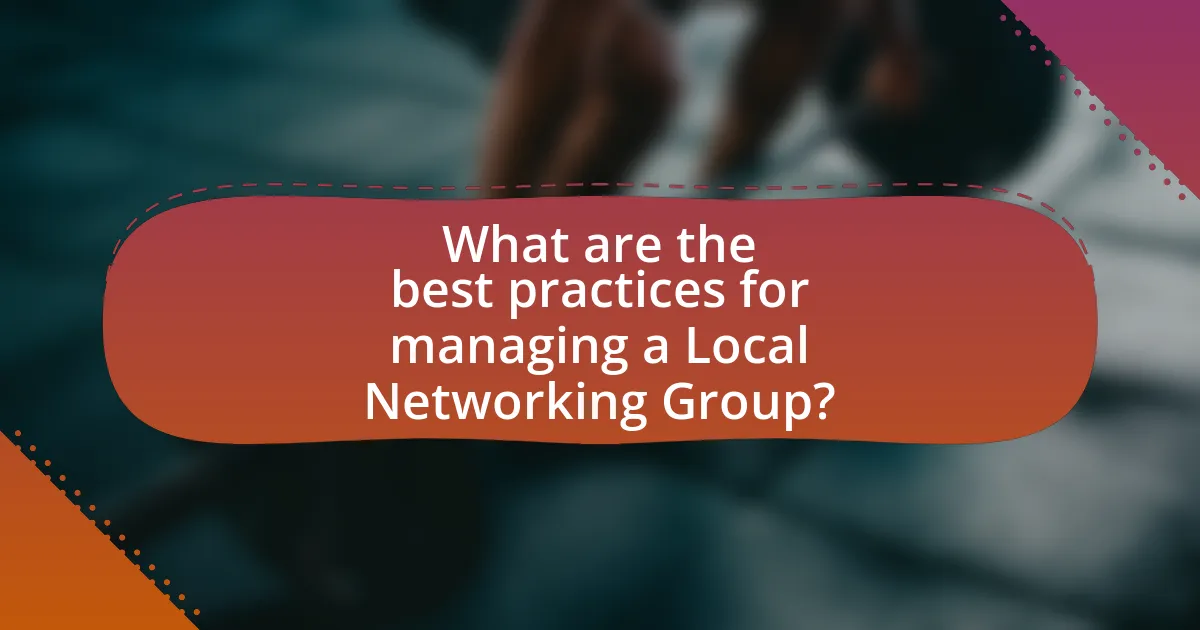
What are the best practices for managing a Local Networking Group?
The best practices for managing a Local Networking Group include establishing clear objectives, fostering member engagement, and maintaining consistent communication. Clear objectives provide direction and purpose, ensuring that all activities align with the group’s goals. Engaging members through regular events, discussions, and feedback mechanisms enhances participation and strengthens relationships. Consistent communication, whether through newsletters, social media, or meetings, keeps members informed and connected, which is essential for sustaining interest and involvement. These practices are supported by research indicating that effective networking groups often have defined goals and prioritize member interaction, leading to higher satisfaction and retention rates.
How do you maintain engagement among group members?
To maintain engagement among group members, regularly schedule interactive activities that encourage participation and collaboration. These activities can include workshops, brainstorming sessions, or social events that foster relationship-building. Research indicates that groups with frequent interactive sessions report higher levels of member satisfaction and commitment, as seen in studies on group dynamics and engagement strategies.
What types of events can you organize to foster networking?
To foster networking, you can organize events such as networking mixers, workshops, panel discussions, and industry-specific meetups. Networking mixers provide informal settings for attendees to connect, while workshops offer skill-building opportunities that encourage collaboration. Panel discussions feature experts sharing insights, which can stimulate conversations among participants. Industry-specific meetups allow individuals within the same field to share experiences and resources, enhancing professional relationships. These event types are effective because they create environments conducive to interaction and relationship-building, essential for successful networking.
How can feedback be used to improve group activities?
Feedback can be used to improve group activities by identifying strengths and weaknesses in performance and collaboration. When group members provide constructive feedback, it fosters an environment of open communication, allowing individuals to understand their contributions and areas for improvement. Research indicates that teams that regularly engage in feedback loops experience a 25% increase in overall productivity, as members feel more valued and motivated to enhance their skills. Additionally, implementing feedback mechanisms, such as surveys or debrief sessions, can lead to more effective planning and execution of future activities, ensuring that the group evolves and adapts to meet its goals.
What challenges might you face in running a Local Networking Group?
Running a Local Networking Group may present challenges such as attracting and retaining members, managing diverse personalities, and securing consistent meeting venues. Attracting members can be difficult due to competition from other networking opportunities and the need to demonstrate value. Retaining members often requires ongoing engagement and relevant programming, which can be resource-intensive. Managing diverse personalities involves navigating different communication styles and expectations, which can lead to conflicts if not handled effectively. Additionally, securing consistent meeting venues can be a logistical challenge, as availability and costs may fluctuate, impacting the group’s ability to meet regularly. These challenges are common in community-building efforts and require strategic planning and adaptability to overcome.
How can you address common issues such as low attendance?
To address common issues such as low attendance, implement targeted outreach strategies that engage potential participants. Research indicates that personalized invitations and reminders can increase attendance rates by up to 30%. Additionally, offering incentives such as refreshments or networking opportunities can further motivate individuals to attend. By analyzing attendance patterns and gathering feedback, organizers can identify barriers and adjust their approach, ensuring that events meet the interests and needs of the community.
What strategies can help resolve conflicts within the group?
Effective strategies to resolve conflicts within a group include open communication, active listening, and mediation. Open communication allows group members to express their concerns and feelings without fear of judgment, fostering an environment where issues can be addressed directly. Active listening ensures that all parties feel heard and understood, which can de-escalate tensions and promote empathy. Mediation involves a neutral third party facilitating discussions to help conflicting members reach a mutually acceptable solution. Research indicates that groups employing these strategies experience improved collaboration and reduced conflict, as evidenced by a study published in the Journal of Conflict Resolution, which found that effective communication and mediation significantly lower conflict levels in team settings.
What are some practical tips for sustaining a successful Local Networking Group?
To sustain a successful Local Networking Group, establish a consistent meeting schedule and create engaging agendas. Regular meetings foster commitment and allow members to build relationships over time. Additionally, encourage active participation by assigning roles or responsibilities to members, which enhances engagement and accountability.
Utilizing social media and email newsletters to keep members informed about events and group activities is crucial, as it maintains interest and involvement. Furthermore, gathering feedback from members regularly helps to adapt the group’s focus to meet their needs, ensuring relevance and satisfaction.
Research indicates that networking groups with structured activities and clear objectives have higher retention rates, demonstrating the importance of organization and member involvement in sustaining success.
